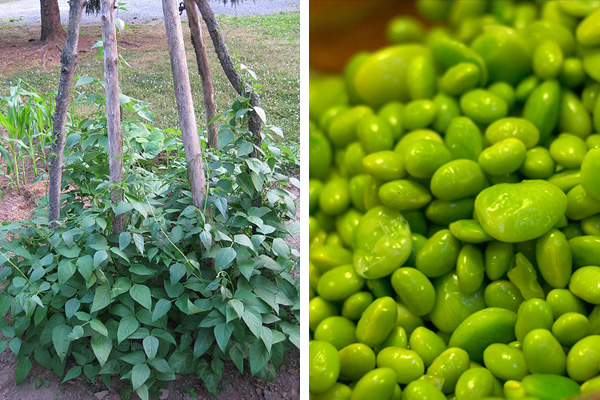-

Erin Donahue -

Christina Barkanic -

Brittany Trott -

Emily Wiley -

Jessica Reilley -

Chris Raines -

Will Nichols -

Emily Reddy -

Michele Marchetti -

Michele Frank -

James Gherardi -

Kit Henshaw -

Christina and Erin -

Kim Tait -

Erin McKinney -

Steve Spanelli -

Sam Komlenic -

Katherine Taylor Grofic -

James Eisenstein -

Jamie Oberdick -

Anna Lombardo -

LacCreta Holland -

Tony Ricci -

Local Food Journey -

Laura Young -

Kristin Camplese -

Harrison's Fresh + Local -

Danielle Matalonis -

Kristine A. -

Linda Weaver -

Naomi Elle Schwartz -

Dana Stuchul -

Cara McShane -

Brittany Smith -

Jessica Illuzzi - Frosty
-

Jessica Paholsky -

James Sechrengost -

Brad Yeckley -

Maya Althouse -

Jordan Reabold -

Kim Chase -

Maria Bryant - Alexandrea Scott
Diverse Beans a Warm-Weather Garden Star
Posted by Jamie Oberdick on 05/31, 2012 at 08:30 AM

Lima bean plants growing up pole supports. Photo Credit Jamie Oberdick. | Lima Beans. Photo Credit Fotopedia.
Beans are a popular garden plant, with good reason—they are one of the tastiest vegetables in the garden. They are also pretty easy to grow, and with a little bit of TLC you can get quite a yield of tasty pods or shelled beans that can be used in all kinds of recipes. Beans are also a perfect garden crop for vegetarians because of their high protein content. What’s not to like?
There are a wide variety of types of bean plants. There are varieties that grow in bushy plants and those that grow in long vines that need a trellis or poles for support. There are Asian long beans that range in size from 12 to 30 inches long and are delicious in stir-fries. Some beans like Blue Lake 274 and rattlesnake pole bean are grown as “snap” beans for their delicious pods, while others like Hutterite soup (they make an AMAZING creamy soup) or any of the lima varieties are grown for the “bean” itself. There are black, purple, red, white, green, yellow, and speckled colored beans.
Beans are also easy to store. You can freeze snap beans after blanching them, allowing you to pull them out later for a great side dish. You can also can them, and in the case of the shell beans like lima, kidney, or black beans, dry them and store them in sealed bags or jars.
But really, beans are just so awesome to eat fresh from the garden, they really are better than store bought. Green bean salad, ham and beans, stir-fried green beans, etc. are all worth the effort you put into gardening.
So, how to grow them? Again, they aren’t a difficult vegetable to grow, so they make a good addition for a beginner’s garden. Here are some tips:
- With few exceptions, beans require a warm ground to germinate and grow. So, planting beans from right about now (last week of May) through June is best. Plant seeds 2-3” apart, about 1” deep.
- Keep an eye on them for pests, which can decimate plants rather quickly, especially when young. Watch the leaves for holes, and check around the plant for visible bugs like cutworms or Japanese beetles. Be sure to spray with the pesticide of your choice, or pick insects off the plants.
- Be sure you know whether you are planting a bush variety, or a pole variety. If you are growing a pole variety, you will need to put a trellis or pole supports for the beans to climb on.
- Beans love water, so make sure you water them frequently. Don’t let them go through hot dry periods. Beans fare best on about an inch of rainwater or equivalent.
- Once you start getting snap beans, don’t let the pods grow to maturity - it causes the plant to shut down production. Frequently picking beans causes the plant to produce more.
![]() Author: Jamie Oberdick
Author: Jamie Oberdick
Bio: Editor, Local Food Journey | Passionate about supporting local food in Central PA
- Our Local Food Journey comes to an end
- Winter isn’t a quiet time at the farm
- Get the taste of garden season right now by growing herbs indoors
- All you need to know about PASA’s Farming for the Future conference









NO COMMENTS